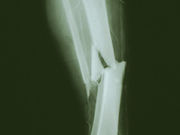Pattern of dietary calcium with fracture risk is U-shaped for older men and possibly for older women
MONDAY, June 6, 2016 (HealthDay News) — Dietary calcium intake seems to have a U-shaped correlation with fracture risk in men and possibly in women, according to a study published online May 21 in the Journal of Bone and Mineral Research.
Aiping Fang, Ph.D., from Peking University in Beijing, and colleagues examined the long-term correlations between low dietary calcium intake and fracture risk in older adults with a plant-based diet. Data were included for 6,210 Chinese men and women, aged 50 years or older, in a sub-cohort based on the China Health and Nutrition Survey.
Over a median follow-up of 7.0 years, the researchers found that 4.34 percent of men and 7.06 percent of women experienced first fracture events. For individuals in the lowest, third, and highest quintile of dietary calcium intake, the crude rates were 4.88, 2.55, and 6.83 per 1,000 person-years at risk for men and 6.72, 7.10, and 11.0 per 1,000 person-years at risk for women. For men, increased fracture risk was seen for dietary calcium intake of more than 778 mg/day (multivariate adjusted hazard ratio [HR], 2.10; 95 percent confidence interval [CI], 1.00 to 4.41) or lower than 275 mg/day (HR, 1.74; 95 percent CI, 1.00 to 3.01); for women, increased fracture risk was seen for dietary calcium intake above 651 mg/day (HR, 1.54; 95 percent CI, 1.00 to 2.38), and a nonsignificant trend of increase was seen for intake below 248 mg/day (HR, 1.00; 95 percent CI, 0.67 to 1.50).
“The patterns of dietary calcium with fracture risk are U-shaped in men and possibly in women,” the authors write.
Copyright © 2016 HealthDay. All rights reserved.








